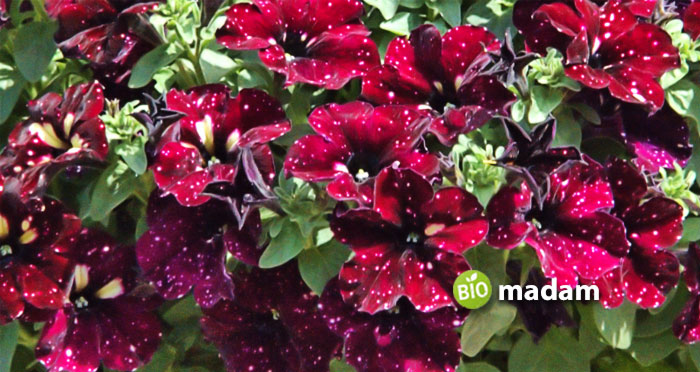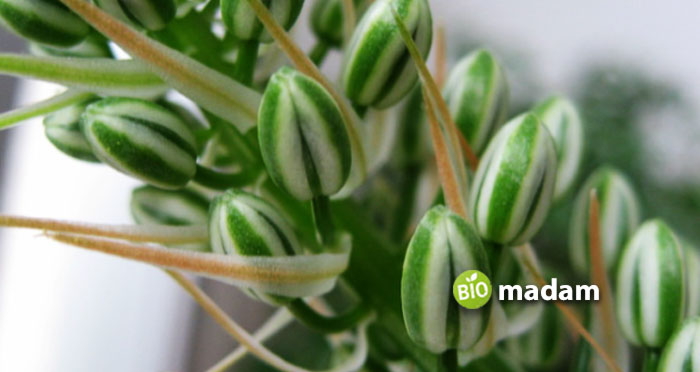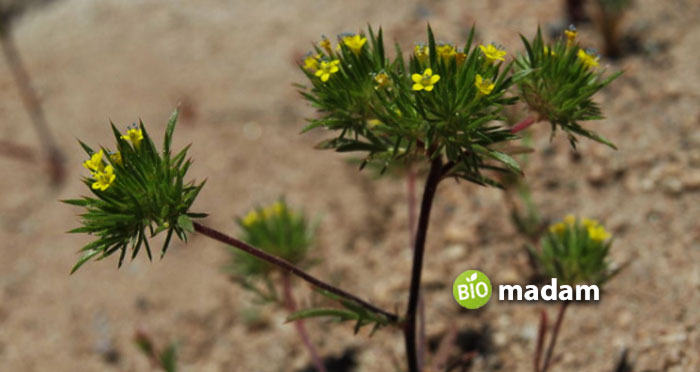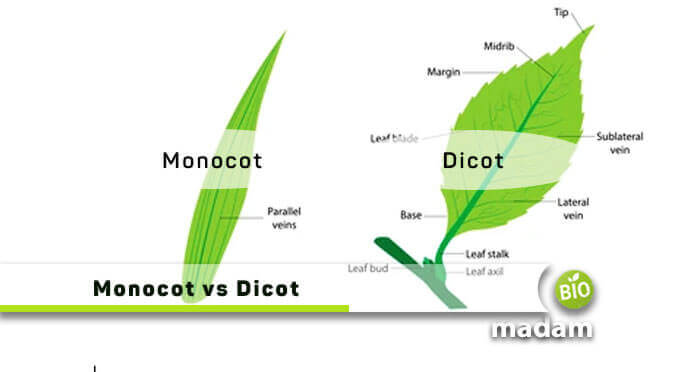Recently updated on March 4th, 2023 at 12:21 pm
There are a lot of plants in the world that botanists classify, just so it gets easy to observe and study. Plants are generally categorized as the presence or absence of flowers. We can further divide them into two primary groups based on their physical appearance and the number of leaves developed.

Cotyledons are an essential component of the embryo present in a seed. All plants are categorized as the presence or absence of seeds. Furthermore, those plants that possess seeds are sub-divided into flowering (angiosperms) and non-flowering (gymnosperms) plants. Flowering plants, then split into monocots and dicots. Today we will discuss the differences between monocots and dicots. So let’s start with a comparison table.
Comparison Table
| Basis of Comparison | Monocots | Dicots |
|---|---|---|
| Cotyledons | One | Two |
| Leaf Style | Long & Narrow Leaf | Broad Leaf |
| Vessel Veins | Parallel structure | Net-like structure |
| Flower Parts | In multiples of 3 | In multiples of 4 or 5 |
| Vascular Bundles in Stem | Scattered | In a ring |
| Roots | Fibrous | Tapered |
| Cambium | Present | Absent |
| Examples | Garlic, wheat, grass, etc. | Cauliflowers, pear, etc. |
What are Monocot Plants?
Monocotyledons (often called monocots) are flowering plants whose seeds typically possess just one embryonic cotyledon. There are almost 60,000 species of monocots that are predominantly herbaceous. Monocots drove their name from the seed composition, with only one cotyledon situated at the end.
Habitat
Monocotyledons are present in diverse habitats in an ecosystem, most commonly in tropical areas. Although they are found in large numbers in low areas, many species can be present in several other regions, e.g., ponds, rivers, lakes and coastal aquatic environments, barren lands, and even polar habitats. Monocots do not usually develop into trees because they lack particular woody tissue.
Characteristics of a Monocot Plant

Flower Pattern
The flower parts of monocotyledon are adequately organized, structured, or arranged in multiples of three, mostly with one stigma and calyx, three stamens, and petals.
Seeds
The seed contains only a single cotyledon.
Leaves
Monocots leaves are usually isobilateral, i.e., both sides look the same and are basically the same; both are directed towards the sun (mostly vertically aligned). The leaves are fragile with parallel venation, plane edge, an elongated sheath, always wrapping the stem. Furthermore, these are fixed, i.e., clearly connected to its base (without a stalk). But a few monocots are still believed to have netted veins, like Smilax.
Stems
Monocots are mostly herbaceous, which means they have delicate, green stems and are not arboraceous (woody). Their stems are mostly branchless and soft. Vascular tissue is arranged in elongated chains referred to as vascular bundles. In monocots, these bundles are widely dispersed throughout the broad cross-section of the stem, with more of the bundles positioned toward the stem edge rather than the middle. This pattern is unusual for monocots.
Roots
Roots can originate either from a primary radicle or come up in groups from the nodes in the stem, known as adventitious roots. Monocots are known to have adventitious roots. The monocot roots do not have a vascular cambium (the region of secondary vascular tissue growth) and therefore lack secondary thickening.
Examples
Corn, rice, sugarcane, sorghum, ginger, orchid, onion, garlic, banana, coconut, palm, tulips, lilies, daffodils, etc., are different monocot examples.

What are Dicot Plants?
Dicotyledons, also called dicots, are flowering plants containing two cotyledons in the seed embryo. There are approximately 175,000 familiar species of dicots. Such plants have specially arranged vascular bundles, giving a cylindrical shape. The vascular system of a dicot plant consists of a cortex and a stele.

Habitat
If you generally take a glance outside your home, every other plant is a dicotyledon. So, dicots are all around us. The most familiar plants are dicots, such as oak trees, cactus, and roses.
Characteristics of a Dicot Plant
Flower Pattern
In dicot plants, flowers are primarily pentamerous, i.e., they are present in multiples of four or five. This character is not always authentic; however, not so simple to use in those flowers with lesser or multiple parts. The dicot flower parts comprise petals, sepals, pistils, and the reproductive component of the plant.
Seeds
Two collateral cotyledons in every seed characterize the dicots. The seed leaves are mostly ring-shaped and bulky, as they are the two halves of the seed.
Leaves
A dicot may have complicated or uncomplicated leaves with the dorsoventral arrangement. They come up with net or reticulate venation and are usually with irregular boundaries, rough or dissected.
Stem
The stems are solid, with vascular bundles present in a circular form that comprises two structures, the xylem and the phloem—the xylem assists in carrying water and minerals from the root to the many parts of the plant. The phloem conveys food prepared inside the leaves to the storage areas. The number of xylem and phloem tissues varies from 2-4, which means that such plants are naturally vascular. They are further differentiated by a sheet of parenchymatous cells called conjunctive tissue.
Roots
These plants contain a tap root system. They further possess two parts:
- The external epidermis often forms root hair.
- The internal endodermis.
In most dicots, the root emerges from the bottom end of the embryo, from an area called the radicle. It brings about an apical meristem that constantly generates root tissue. Root systems usually perform the following functions:
- Intake of water and organic substances
- Fixing the plant body to the soil
- A storehouse of food and nutrients
Examples
Roses, oak trees, daisies, peas, beans, cactus, magnolia, marigolds, sunflowers, buttercups, asters, dandelions, etc., are common dicot examples.

Differences between Monocot and Dicot
We previously had a general overview of both terminologies. Now let’s grab the differences between monocot and dicot in detail.
Brief Definition
Monocot
All those flowering plants containing a single seed leaf inside the seed coat are monocots.
Dicot
Dicotyledons are unique angiosperm members, containing seeds with a pair of cotyledons.
Root System
Monocot
Monocots have their own fibrous root system.
Dicot
Whereas, on the other hand, dicots possess a tap root system. Nevertheless, a few dicots might also own an adventitious root system.
Stems
Monocot
Such plants have herbaceous, branchless, and delicate stems. They lack cambium and cannot enlarge in diameter.
Dicot
On the other hand, dicots have either herbaceous or arboraceous stems. Similarly, cambium is also present, and it can enlarge in diameter.
Pollen Grains
Monocot
The pollen grains in such plants particularly have a single ridge or hole.
Dicot
In contrast, dicot plants have tricolpate-type pollen grains, meaning that they have three clefts reaching the external layer.
Pollen Tube
Monocot
The pollen tube of a monocot plant possesses only one pore.
Dicot
In contrast, there may be three or more than three pores in the pollen tube of a dicot seed.
Germination
Monocot
The germination in monocots usually gives rise to only one leaf. These leaves are elongated and tapered most of the time, just like an adult leaf. The seed germination here is most often hypogeal.
Dicot
On the contrary, dicot seed germination brings about a pair of seed leaves. They preserve the young plants’ nutrients, which are usually bulkier than the actual leaves. The seed germination here, unlike monocots, can be either hypogeal or epigeal.
Flower Parts
Monocot
The flower parts are referred to as trimerous in monocots. It means that the flowers are arranged in multiples of three or equal to three.
Dicot
On the contrary, dicots have either tetramerous or pentamerous designs, referring to the flower parts organized in multiples of four or five.
Secondary Growth
Monocot
Such plants do not experience any secondary growth due to the deprivation of cambium; however, they do go through primary growth.
Dicot
On the other hand, dicots can undergo a secondary growth process as they possess lateral meristem or cambium.
Conclusion
It’s pretty easy to understand the variations between monocots and dicots, as the names themselves show the difference. All monocot plants consist of a single seed leaf, whereas the dicots include two embryonic leaves. All other differences are extensively mentioned above to go through them in detail for better comprehension.

Anna has completed her degree in Pharmacy from the University of Hawaii. She is serving as a research assistant in a pharmaceutical company. She had a great interest in writing blogs, traveling to different parts of the US, and trying delicious recipes in her spare time.

